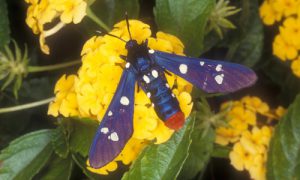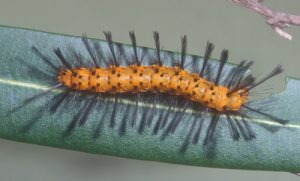Oleander caterpillars, which are active on some oleanders during summer, can provide a number of gardening lessons.
The adult moth is striking in appearance. The bluish to purplish moth has white dots on its black wings. The moths resemble wasps as they fly in and around oleander shrubs.
It’s the orange caterpillars with black spots and black hairs that cause problems for some gardeners.
Caterpillars are the larval stage of butterflies and moths. In order to enjoy watching butterflies and moths feeding on the nectar of flowers, some of the caterpillars must survive to become adult butterflies and moths. This is lesson number one.
Oleander caterpillars usually only feed on oleander plants. Oleanders are native to areas of Europe and Asia. This is lesson number two.
Oleander caterpillars benefit by us planting their food source in Florida.
This relationship between pest and plant is referred to as the key plant, key pest concept. Some other examples include St. Augustinegrass and chinch bugs, gardenias and whiteflies, crape myrtles and crape myrtle aphids, azaleas and azalea caterpillars, camellias and tea scale, roses and black spot, pecans and pecan scab, squash and squash vine borers.
Understanding this concept can be helpful in designing a “low maintenance” landscape.
When you plant roses, you plant everything that goes with roses, including the time and money required to maintain them. This applies to St. Augustinegrass, pecan trees, squash and oleanders. This is lesson number three.
Oleander caterpillars can temporarily damage the appearance of oleanders. But they cause no long-term damage for the plant. This is lesson number four. The damage is aesthetic. Oleander caterpillars can consume great numbers of leaves. However, if the plant is otherwise healthy, new leaves will be produced and the plant will continue to grow. The damage is temporary; there will be no evidence the plant ever had a problem.
To spray or not to spray for oleander caterpillars has to do with a person’s tolerance level.
If you can’t tolerate having oleander caterpillars around and the temporary aesthetic damage they cause, consider the use of Bacillus thuringiensis. It is sold under a number of brand names and many times is referred to as Bt. This bacterium only controls caterpillars so it is friendlier for the beneficial insects. When using any pesticide, always follow the label directions and precautions.
Here are links to UF/IFAS Extension publications with more info.
- Evaluate and Renovate Landscape During Fall - October 30, 2025
- Summer is Too Hot for Lawn Herbicides - August 23, 2025
- Nuisance Gnats abound in Northwest Florida this spring - June 26, 2025


